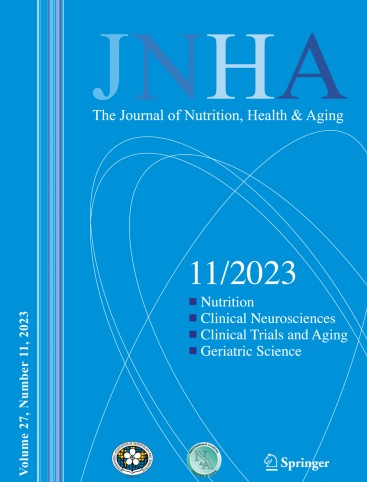在老年妇女中,血清klotho与腰围呈负相关,但与男女跌倒或肌肉骨骼测量无关
IF 4
3区 医学
Q1 GERIATRICS & GERONTOLOGY
引用次数: 0
摘要
klotho血清是一种衰老的生物标志物,与心血管疾病、肾脏疾病和骨关节炎相关,但与肌肉和骨骼衰老相关的信息有限。我们评估了血清klotho作为老年人身体成分、跌倒几率、肌肉力量和骨矿物质密度(BMD)的年龄相关变化的潜在生物标志物。STOP IT临床试验的探索性分析。在塔夫茨大学设立美国农业部人类营养衰老研究中心。健康成年人(178名男性;209名妇女)年龄≥65岁,每天服用700国际单位维生素D3加500毫克钙或安慰剂治疗3年。方法:通过双能x线吸收仪(DXA)检测血清klotho(6个月或12个月)与跌倒几率、基线和3年身体成分、握力、脊柱和髋关节骨密度变化的关系。结果两组患者血清klotho水平无显著差异。经年龄、体力活动、治疗方案、肾功能、季节和测量klotho的时间等因素调整后,两臂合并后,女性的klotho与腰围呈负相关(β= -0.007, p = 0.01),而男性无。血清klotho与跌倒几率、体脂或瘦质量比例、握力、脊柱或髋部骨密度及其3年变化无关。结论健康老年女性血清klotho与腰围呈负相关,而男性无相关。血清klotho似乎不是老年女性或男性肌肉骨骼状态的有用生物标志物。本文章由计算机程序翻译,如有差异,请以英文原文为准。
Serum klotho is inversely associated with girth in older women but is not associated with falls or musculoskeletal measures in either sex
Objective
Serum klotho, a biomarker of aging, has been associated with cardiovascular disease, kidney disease, and osteoarthritis, but information on an association with muscle and bone aging is limited. We assessed serum klotho as a potential biomarker of age-related changes in body composition, odds of falling, muscle strength and bone mineral density (BMD) in older adults.
Design
Exploratory analysis within the STOP IT clinical trial.
Setting
USDA Human Nutrition Research Center on Aging at Tufts University.
Participants
Healthy adults (178 men; 209 women) age ≥65 years treated daily for 3 years with either 700 IU of vitamin D3 plus 500 mg of calcium or placebo.
Methods
We examined associations of serum klotho (at 6 or 12 months) with odds of falling, and with baseline and 3-year changes in body composition, grip strength and spine and hip BMD by dual-energy X-ray absorptiometry (DXA).
Results
Serum klotho levels did not differ significantly in the two treatment arms. In the arms combined, klotho was inversely associated with waist circumference (β= -0.007, p = 0.01) in the women but not in the men, after adjustment for age, physical activity, treatment assignment, kidney function, season and time of klotho measurement. Serum klotho was not associated with odds of falling or with proportion of body fat or lean mass, grip strength, or spine or hip BMD or their 3-year changes in men or women.
Conclusion
Serum klotho is inversely related to waist circumference in healthy older women but not men. Serum klotho does not appear to be a useful biomarker of musculoskeletal status in older women or men.
求助全文
通过发布文献求助,成功后即可免费获取论文全文。
去求助
来源期刊
CiteScore
7.80
自引率
3.40%
发文量
136
审稿时长
4-8 weeks
期刊介绍:
There is increasing scientific and clinical interest in the interactions of nutrition and health as part of the aging process. This interest is due to the important role that nutrition plays throughout the life span. This role affects the growth and development of the body during childhood, affects the risk of acute and chronic diseases, the maintenance of physiological processes and the biological process of aging. A major aim of "The Journal of Nutrition, Health & Aging" is to contribute to the improvement of knowledge regarding the relationships between nutrition and the aging process from birth to old age.

 求助内容:
求助内容: 应助结果提醒方式:
应助结果提醒方式:


